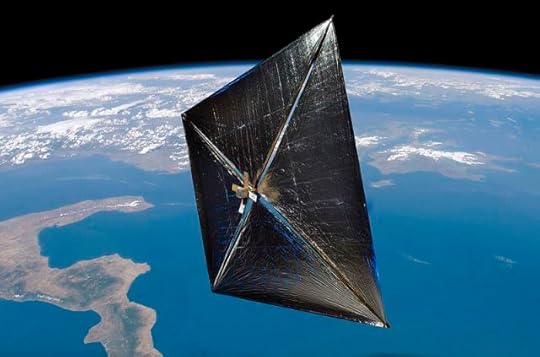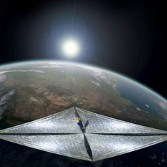Solar Sail Projects
Light pressure has been demonstrated as a force that can, indeed, move a spacecraft. Back in 1974, when Mariner 10 was running low on fuel, NASA utilized light pressure against its solar panels to adjust its trajectory. Although this was a limited demonstration, light sail technology holds sufficient promise that scientists around the world are trying to turn this science fictional idea into reality. Public and private teams in the United States, Japan, and Europe are all actively working on solar sail projects.
Although it’s not as heavily publicized as some projects, NASA has been on the forefront of light sail development. On November 19, 2010, they launched a solar sail “nanosatellite” called NanoSail-D. It was a 100-square-foot solar sail that was deployed from NASA’s FASTSAT Satellite on January 20, 2011. Four booms with sails deployed from a craft about the size of a lunchbox. The image above is an artist’s conception of the craft, but to learn more about NanoSail-D and to see photos of the sail during it’s 240-day voyage, visit: http://www.nasa.gov/mission_pages/smallsats/nanosaild.html
In the longer term, NASA is developing a somewhat larger prototype solar sail. This larger sail would have an area approximately 13,000 square feet with a payload of 110 pounds. This makes it about seven times larger than the largest solar sail ever deployed. While the NanoSail-D project was essentially a simple sheet of reflective material designed to test the concept of solar sailing, the larger solar sail would include four small steering sails to test maneuverability of the craft. Currently, this larger prototype sail is scheduled to launch on a Falcon 9 in 2015. You can read more about this mission at: http://www.nasa.gov/mission_pages/tdm/solarsail/solarsail_overview.html
Perhaps the most prominent private group working to build a solar sail is the Planetary Society. They’re a non-profit organization in the United States dedicated to the support of space exploration. They attempted to launch a solar sail called Cosmos 1 back in 2005. Unfortunately, it was lost when the launch vehicle it was aboard—a Volna rocket launched from a Russian submarine—exploded on the way to orbit. The original craft looked like an octagonal mirror. Eight triangular sails surrounded a central hub. Each sail was mounted to the hub by a rotating mast. By changing the angle of the sails, the craft’s course could be adjusted. The updated project is called LightSail-1 and appears to be a much simpler design as shown in the photo at the top of the paragraph. For more information, visit: http://www.planetary.org/explore/projects/lightsail-solar-sailing/
Interest in solar sail technology isn’t limited to the United States. In 2011, the Japan Aeronautic Exploration Agency or JAXA successfully deployed a small solar sail called IKAROS (for Interplanetary Kite-craft Accelerated by Radiation Of the Sun). The test successfully demonstrated both sail deployment and the ability of a craft to fly by photon pressure. Later this decade, they hope to launch a probe to Jupiter that will be propelled by solar sails. An artist’s conception is shown below. You can learn more about the IKAROS mission, and see a cool gif of the sail in flight at: http://www.jspec.jaxa.jp/e/activity/ikaros.html
The European Space Agency has also been working on a prototype solar sail, but there is little information at this point about when they might try a flight. They appear to have a near-term project using solar sail nanosatellites to help remove debris from Earth orbit.
As we move toward the middle of the 21st century’s second decade, we find ourselves searching for “green” technologies that utilize the resources we have available as wisely as possible. Solar sails appear to be a promising, green technology that would allow humans to explore space wisely. Indeed, it is the only propulsion technology within our reach that could conceivably propel a spacecraft to near the speed of light.
In the next installment, I’ll look at solar sails in science fiction. In the meantime, you can learn more about my novel, The Solar Sea, which is set aboard a solar sail spacecraft at TheSolarSea.com. The novel is available at:
Amazon.com
Barnes and Noble
OmniLit









